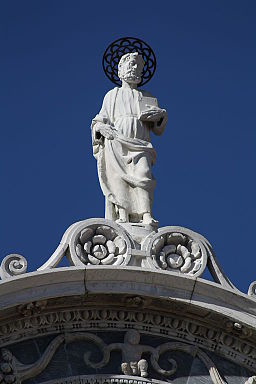The furta sacra (or holy theft) of a saint’s bones in the Middle Ages was often viewed as a heroic act of rescuing a saint from people that possess his relics wrongfully. They were gleefully written about in translation stories (an entire Catholic genre about translation of a saint’s body from one place to another). Perhaps a bit like sanctified heist stories.
A good example of the kind of tale that a 16th century Venetian in Lepanto might have delighted in telling and retelling is the following story of how Saint Mark’s bones came to rest where they belonged, in Venice (which was nicknamed “the Republic of Saint Mark”).
![By Stefano Bolognini (Own work) [Attribution], via Wikimedia Commons](https://nmgrubens.com/wp-content/uploads/2016/04/256px-Scuola_Grande_di_San_Marco_-2528Venice-2529_by_Stefano_Bolognini-200x300.jpg) |
| Scuola Grande di San Marco in Venice |
In 829, two Venetian merchants named Buono and Rustico were doing some illegal trading in Alexandria (Emperor Leo V had forbidden trade with Muslims at that time). They heard that the body of San Marcos, or Saint Mark, was housed in a church close by. This, of course, seemed a cosmic injustice to two loyal subjects of the Republic of Saint Mark. Visiting the church they met two monks, Stauracius and Theodorus. These monks were worried about the safety of Saint Mark’s body because of a recent rash of Muslim persecution against Christians, and thus were easily convinced to help steal the body. The story goes that the four managed to carefully remove Saint Mark’s remains from a sealed silk wrapping, and replace it with another body they snuck into the tomb (that of one named Saint Claudius, apparently). They were about to get away without a hitch, when one of the church’s prelates noted that the tomb smelled differently. You see, holy relics in those days were thought to give off a sweet “holy odor” and it was noted that Saint Mark’s scent was missing. Immediately the port authorities were alerted to inspect ships for the body. The clever Buono and Rustico, however, hid it in a barrel of pork. The port authorities were Muslim, and had religious objection to pork as unclean, and the clever corpse snatchers passed the inspection and sailed successfully back to the Republic of Saint Mark, with Saint Mark.
(Story retold from original written in Thomas Madden’s book on Venice.)

That is hilariously bizarre! What a weird chapter of history to find. 😀